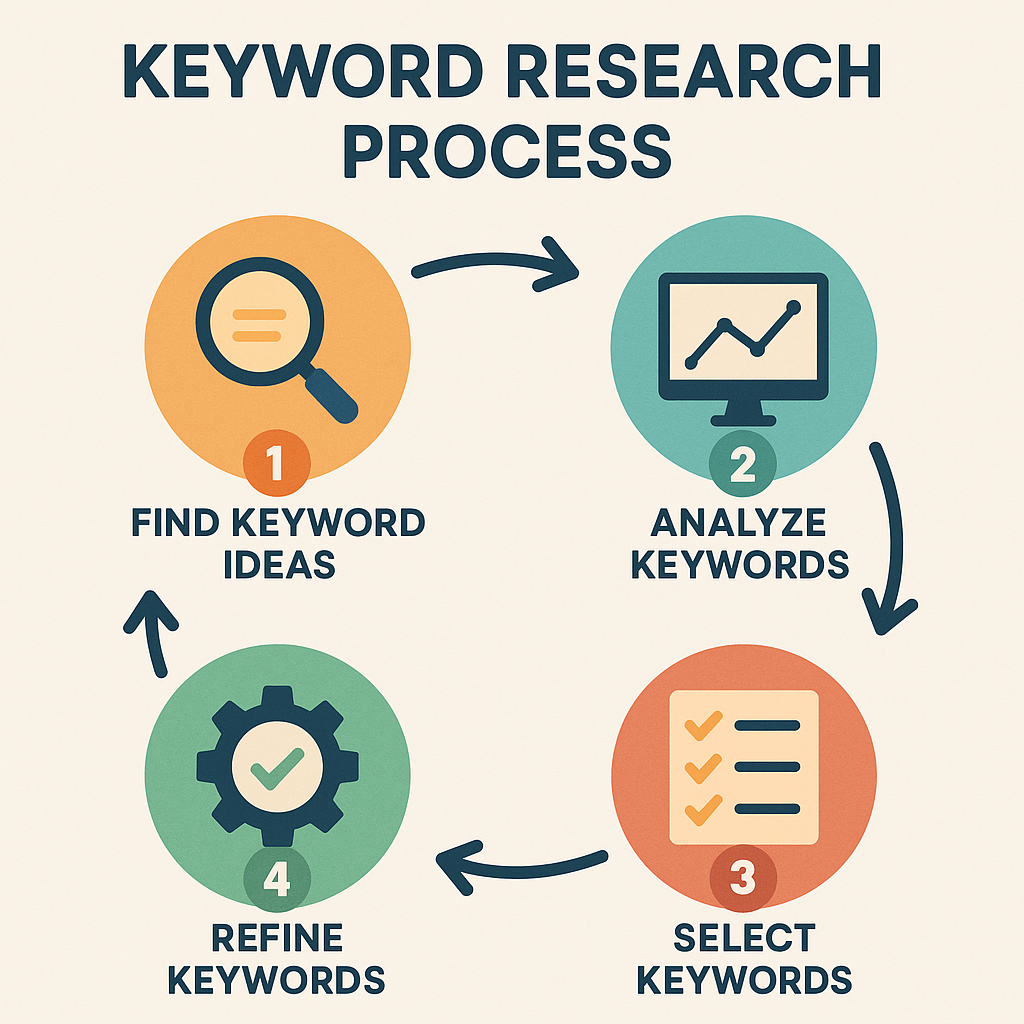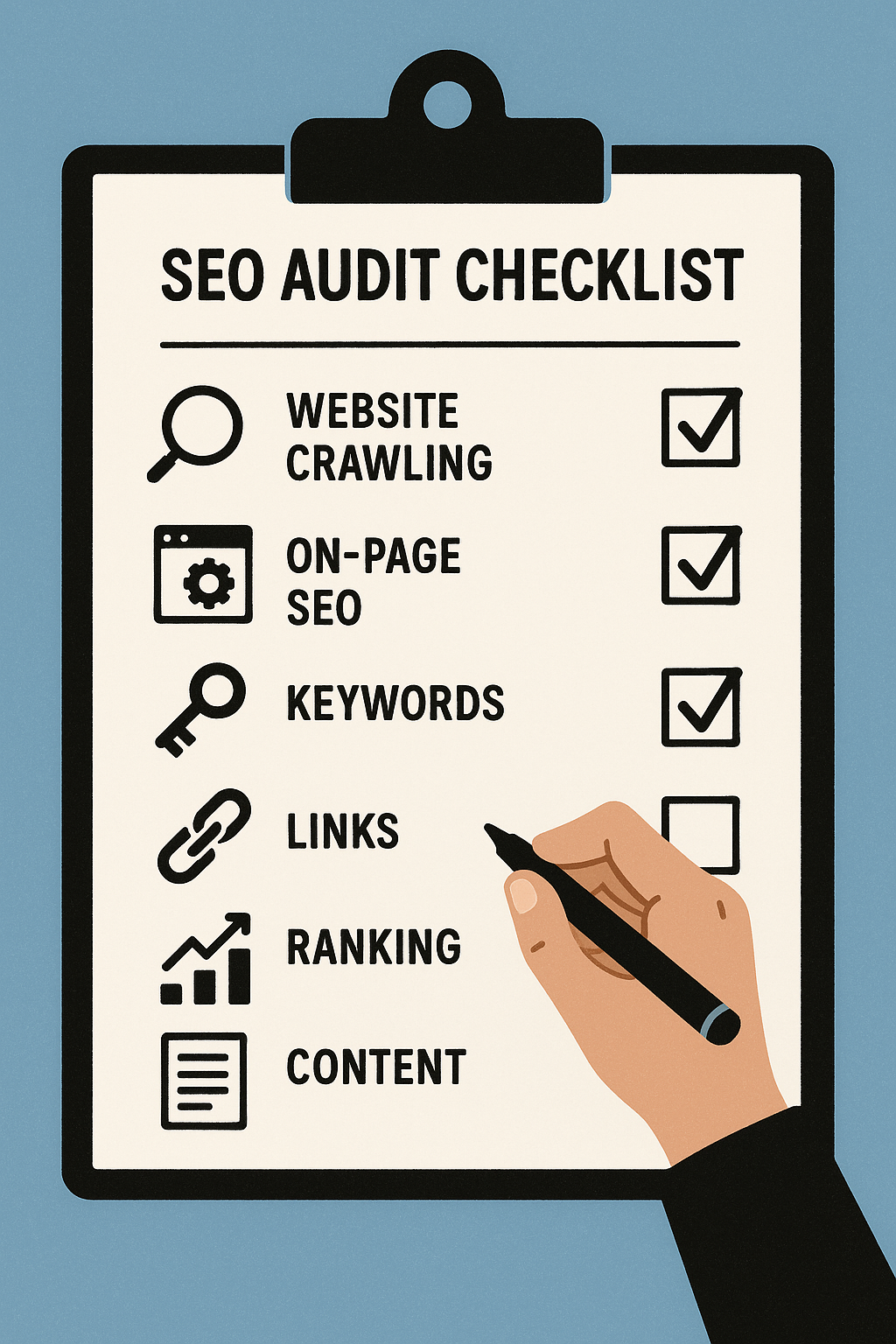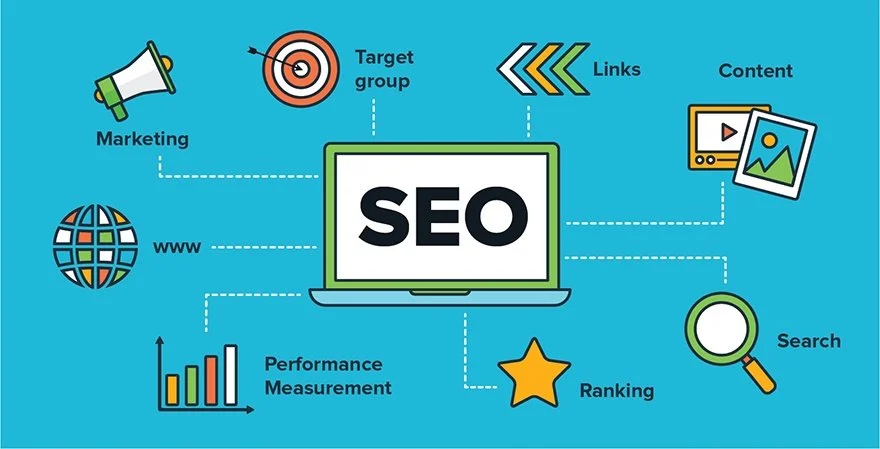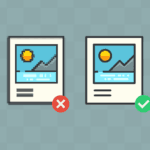Here is a comprehensive guide for both hiring managers and SEO candidates to navigate the most challenging and high-level SEO interview questions.
1. How do you conduct comprehensive keyword research?
Use tools like Google Keyword Planner, Ahrefs, and SEMrush to identify seed keywords. Analyze search volume, keyword difficulty, user intent, and competitor gaps. Group keywords by topic for content clusters and prioritize based on business goals and conversion potential.

2. What is search intent and how do you optimize for it?
Search intent refers to the purpose behind a query: informational, navigational, transactional, or commercial. Match content format and depth to the intent—use how-to guides for informational, product pages for transactional, and comparison pages for commercial research.
3. Explain the role of TF-IDF in content optimization.
Term Frequency–Inverse Document Frequency (TF-IDF) identifies the importance of keywords relative to a set of documents. Use TF-IDF analysis to ensure relevant term usage without keyword stuffing, improving semantic relevance and ranking potential.
4. What is Latent Semantic Indexing (LSI) and why is it important?
LSI detects related terms and concepts in content. Incorporate LSI keywords to enhance topical coverage, increase content depth, and help search engines better understand context and relevance.
5. Describe your approach to on-page SEO audits.
Review title tags, meta descriptions, headers, URL structures, internal linking, content quality, image alt attributes, and schema. Identify missing elements, duplicate content, and optimize for target keywords and user experience.

6. How do you optimize site structure for crawlability?
Use a logical URL hierarchy and silo structure. Implement breadcrumb navigation, XML sitemaps, and an optimized robots.txt. Ensure no orphan pages and use internal links to distribute link equity evenly.
7. What strategies improve Core Web Vitals?
Focus on Largest Contentful Paint (LCP), First Input Delay (FID), and Cumulative Layout Shift (CLS). Optimize images, leverage lazy loading, minimize JavaScript, use efficient caching, and implement preloading for critical assets.
8. Explain the importance of mobile-first indexing.
Google primarily uses the mobile version of content for indexing and ranking. Ensure responsive design, fast loading on mobile, and mobile-friendly navigation to maintain and improve mobile rankings.
9. How do you handle canonicalization issues?
Identify duplicate content across URLs. Use canonical tags to point to the preferred version. Implement 301 redirects where appropriate and ensure sitemap entries match canonical URLs.
10. What is hreflang and how do you implement it?
Hreflang tags signal language and regional targeting for multilingual content. Add hreflang attributes in the <head> section or XML sitemap, referencing all language versions including self-referencing tags.
11. Describe accelerated mobile pages (AMP) and their benefits.
AMP provides a stripped-down HTML framework for lightning-fast mobile pages. Benefits include improved mobile load times, increased visibility in mobile carousels, and potentially higher click-through rates.
12. How do you conduct technical SEO audits?
Use tools like Screaming Frog and Sitebulb to crawl the site. Check for broken links, XML sitemap errors, server response codes, structured data issues, and indexation anomalies.
13. What is schema markup and why use it?
Schema markup adds structured data to HTML, helping search engines understand content. Implement JSON-LD for products, reviews, FAQs, and articles to enable rich snippets and enhance click-through rates.
14. Explain the process of backlink gap analysis.
Compare your backlink profile with competitors using Ahrefs or SEMrush. Identify high-authority domains linking to competitors but not to you. Prioritize outreach to those domains with relevant, valuable content.
15. How do you perform a content gap analysis?
Audit competitor pages ranking for your target keywords. Identify topics and subtopics they cover that you don’t. Create or expand content to fill gaps, ensuring comprehensive coverage.
16. What is evergreen content and how do you maintain it?
Evergreen content remains relevant over time. Regularly update statistics, examples, and internal links. Monitor performance and refresh headlines or CTAs to sustain traffic and rankings.
17. Describe your method for measuring content ROI.
Track organic traffic, bounce rate, time on page, and conversions. Use UTM parameters to attribute leads or sales to specific pieces. Calculate cost per acquisition versus revenue generated.
18. How do you optimize for voice search?
Target question-based long-tail keywords. Structure content in concise Q&A format. Ensure pages load quickly on mobile and use schema to enhance visibility.
19. Explain your approach to local SEO.
Optimize Google My Business listing, acquire local citations, and manage NAP consistency. Build localized landing pages, create geo-targeted content, and gather genuine local reviews.
20. What factors influence mobile site speed?
Image optimization, minified CSS and JavaScript, server response time, use of CDNs, and eliminating render-blocking resources all contribute to faster mobile performance.
21. How do you optimize images for SEO?
Compress images with lossless tools, use descriptive file names and alt text, implement responsive images with srcset, and lazy-load offscreen images to improve LCP.
22. What is content cannibalization and how do you fix it?
Content cannibalization occurs when multiple pages target the same keyword. Consolidate or merge pages, apply 301 redirects, and ensure each page has distinct target keywords.
23. How do you conduct a technical log file analysis?
Analyze server logs to track crawler behavior. Identify crawl frequency, errors, and abandoned URLs. Use insights to optimize crawl budget and fix inaccessible pages.
24. What role does JavaScript play in SEO and how do you optimize it?
JavaScript can affect crawlability and rendering. Use server-side rendering or pre-rendering, defer non-critical scripts, and ensure critical content is in static HTML.
25. Describe the impact of page experience on SEO.
Google’s page experience signals include Core Web Vitals, mobile friendliness, HTTPS, and safe browsing. Optimize each to enhance user satisfaction and rankings.
26. How do you audit and clean up toxic backlinks?
Use backlink audit tools to identify spammy links by domain authority, relevance, and anchor text. Create a disavow file for persistent toxic links after attempted outreach removal.
27. What is link equity and how is it distributed?
Link equity (link juice) flows through internal and external links. Use strategic internal linking, 301 redirects, and nofollow attributes to channel equity to priority pages.
28. Explain siloing and topic clusters.
A silo structure organizes content into thematic groups. Central pillar pages link to cluster content, which in turn links back, strengthening relevance signals and improving site architecture.
29. What is crawl budget and how do you optimize it?
Crawl budget is the number of pages Googlebot crawls per day. Optimize by fixing server errors, removing low-value pages, and updating critical pages regularly.
30. How do you leverage Google Search Console for SEO?
Monitor index coverage, performance reports, and URL inspection. Identify and fix errors, track clicks and impressions, submit sitemaps, and analyze enhancement reports.
31. Explain orphan pages and their SEO impact.
Orphan pages have no internal links pointing to them, making them difficult to discover. Identify via crawl tools and link from relevant pages to integrate them into site structure.
32. What is HTTP/2 and how does it benefit SEO?
HTTP/2 supports multiplexing, header compression, and server push. These features reduce latency and improve load speeds, positively impacting user experience and rankings.
33. How do you implement automated SEO reporting?
Use Data Studio or proprietary dashboards pulling from Google Analytics, Search Console, and third-party APIs. Automate data refresh and visualization to track KPIs and share insights.
34. Describe the process for multi-domain or multi-site SEO.
Maintain consistent branding and tracking across domains. Use hreflang for international domains. Consolidate analytics and ensure cross-domain canonicalization and structured internal linking.
35. What’s your strategy for algorithm update response?
Monitor rankings and traffic for volatility. Identify affected pages and correlation with update focus (e.g., E-A-T, page experience). Prioritize fixes and document changes for future reference.
36. How do you conduct competitor technical audits?
Crawl competitor sites to compare site speed, mobile performance, URL structures, schema usage, and backlink profiles. Identify areas where they outperform and adapt strategies accordingly.
37. What is E-A-T and how do you demonstrate it?
Experience, Expertise, Authoritativeness, and Trustworthiness (E-A-T) is Google’s quality standard. Showcase through expert authorship, citations, case studies, secure site practices, and transparent governance.
38. Describe how you optimize for featured snippets.
Analyze snippet-winning content. Structure answers using concise definitions, lists, or tables in HTML. Use heading tags and schema to increase snippet eligibility.
39. What role does HTTPS play in SEO?
HTTPS ensures data encryption, user trust, and improved security. Google uses it as a lightweight ranking signal; migrate all content to HTTPS and update internal links.
40. How do you measure and improve dwell time?
Assess dwell time via Analytics (session duration) and heatmaps. Enhance UX with clear CTAs, engaging visuals, and optimized content structure to reduce bounce rates.
41. Explain pagination and SEO best practices.
Use rel=”prev” and rel=”next” or view-all pages. Ensure paginated content has unique titles and meta descriptions. Implement content summaries to improve user navigation.
42. How do you manage large-scale migrations?
Plan comprehensive audit—inventory URLs, content, backlinks, and rankings. Map redirects, update sitemaps, perform staging tests, and monitor post-launch using analytics and crawl tools.
43. What is a disavow file and when should you use it?
A disavow file tells Google to ignore specified backlinks. Use it only after failed removal attempts and when toxic links significantly harm rankings.
44. Describe your approach to international SEO.
Use country-specific domains or subdirectories. Implement hreflang, translate content accurately, and target local hosts or CDNs for improved performance.
45. How do you optimize site search internal results?
Analyze internal search terms to discover user intent. Improve navigation, implement autocomplete, and optimize landing pages for frequently searched internal queries.
46. Explain progressive web apps (PWAs) and SEO.
PWAs offer app-like experiences in the browser. Ensure server-side rendering of core content, use push notifications sparingly, and maintain crawlable URLs for SEO.
47. What is log file monitoring and why is it useful?
Regularly review server logs to track crawler access patterns, identify resource bottlenecks, and detect anomalies in bot behavior, enabling fine-tuning of crawl budget.
48. How do you balance SEO with UX in design?
Collaborate with designers to ensure fast load times, clear navigation, and accessible layouts. Use A/B testing to validate UX changes that also adhere to SEO best practices.
49. Describe machine learning applications in SEO.
Leverage ML for predictive keyword performance, content topic modeling, and automated anomaly detection in traffic or ranking data to inform proactive optimizations.
50. What emerging SEO trends should experts watch?
Focus on AI-driven content analysis, Google’s evolving generative search, neural matching improvements, and privacy-centric indexing such as on-device ranking signals.
This article equips both hiring managers and SEO candidates with the most advanced and up-to-date expert-level SEO interview questions and detailed answers to ensure thorough preparation and effective evaluation.



